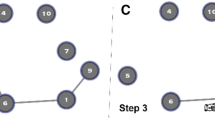Abstract
We describe a situation of distance learning based on collaborative production occurring within groups over a significant time span. For such a situation, we suggest giving priority to monitoring and not to guiding systems. We also argue that we need models which are easily computable in order to deal with the heterogeneous and the large scale amount of data related to interactions, i.e. models relying on theoretical assumptions which characterise the structures of groups and of interactions. Social Network Analysis is a good candidate we applied to our experiment in order to compute communication graphs and cohesion factors in groups. This application represents an essential part of a system which would enable tutors to detect a problem or a slowdown of group interaction.
Access this chapter
Tax calculation will be finalised at checkout
Purchases are for personal use only
Preview
Unable to display preview. Download preview PDF.
Similar content being viewed by others
References
Berge, C.: Graphs and Hypergraphs. Dunod, Paris (1973)
Block, N.: “Holism, Mental and Semantic”. In The Routledge Encyclopedia of Philosophy (1998), http://www.nyu.edu/gsas/dept/philo/faculty/block/
Chanier, T.: Créer des communautés d’apprentissage à distance. Les dossiers de l’Ingénierie Educative, no 36 sur “Les communautés en ligne”, CNDP, Montrouge (2001) 56–59, http://lifc.univ-fcomte.fr/RECHERCHE/P7/pub/cndpIE/cndpIE.htm
Degenne, A., Forsé, M.: Les réseaux sociaux. Armand Colin, Paris (1994)
Fjuk, A., Ludvigsen, S.: The Complexity of Distributed Collaborative Learning: Unit of Analysis. Proceedings of EURO-CSCL’2001 Conference, Maastricht (2001) http://www.mmi.unimaas.nl/euro-cscl/Papers/51.doc
GraphViz Home page (2000) http://www.graphviz.org
Henri, F., Lundgren-Cayrol, K.: Apprentissage collaboratif à distance. Presses de l’Université du Québec, Québec (2001)
Jermann, P., Soller, A., Muehlenbrock, M.: From mirroring to guiding: a review of state of art technology for supporting collaborative learning”. Proceedings of EURO-CSCL’2001 Conference, Maastricht (2001) http://www.mmi.unimaas.nl/euro-cscl/Papers/197.pdf
Mbala, A., Reffay, C., Chanier, T.: Integration of automatic tools for displaying interaction data in computer environments for distance learning. This issue, Biarritz, France (2002)
Nurmela K.A., Lehtinen E., Palonen T.: Evaluating CSCL log files by Social Network Analysis. Proceedings CSCL’1999 Conference, Palo Alto, CA: Stanford University (1999) 434–444. http://kn.cilt.org/cscl99/A54/A54.HTM
Salmon, G.: E-moderating: The key to teaching and learning Online. Kogan, London (2000)
Scott, J.: Social Network Analysis. A handbook. SAGE Publication, London (1991)
Woodruff E.: Concerning the Cohesive Nature of CSCL Communities. Proceedings of CSCL’1999 Conference, Palo Alto, CA: Stanford University (1999) 677–680 http://kn.cilt.org/cscl99/A81/A81.HTM
Wortham D.W.: Nodal and matrix analyses of communication patterns in small groups. Proceedings CSCL’1999 Conference, Palo Alto, CA: Stanford University, (1999) 681–686 http://kn.cilt.org/cscl99/A82/A82.HTM
Author information
Authors and Affiliations
Editor information
Editors and Affiliations
Rights and permissions
Copyright information
© 2002 Springer-Verlag Berlin Heidelberg
About this paper
Cite this paper
Reffay, C., Chanier, T. (2002). Social Network Analysis Used for Modelling Collaboration in Distance Learning Groups. In: Cerri, S.A., Gouardères, G., Paraguaçu, F. (eds) Intelligent Tutoring Systems. ITS 2002. Lecture Notes in Computer Science, vol 2363. Springer, Berlin, Heidelberg. https://doi.org/10.1007/3-540-47987-2_8
Download citation
DOI: https://doi.org/10.1007/3-540-47987-2_8
Published:
Publisher Name: Springer, Berlin, Heidelberg
Print ISBN: 978-3-540-43750-5
Online ISBN: 978-3-540-47987-1
eBook Packages: Springer Book Archive




